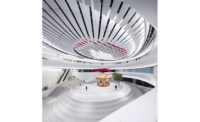Architectural Record: Is the pavilion ready for its opening May 1?
Yichen Lu: The envelope of the building is finished. The workers are focusing on the interior design and installing the exhibitions.
What are the exhibitions about?
There are two parts. One consists of the displays of 11 provinces. Another part is a 4,000-square-foot wheat field. We call it the wheat field, but it’s made of 22,000 aluminum stalks. LED tubes set into the stalks become a screen. Looking down from above, you’ll see videos on life in China. It is going to be spectacular.
Is there one person you report to?
The CCPIT has about 15 people on site right now. That’s lots of comments, and lots of requirements.
Do you find it intimidating to be representing China on a world stage?
When we do design we try not to think about the political implications. We just try to do a great piece of architecture.
Why do you think you won the competition?
I think it was because of my background. I come from China, but I studied at Yale, and I practiced in Los Angeles and New York.
What made you decide to locate your firm in New York?
Before I chose the location, I did some comparisons between Chinese architects and American architects. In China, the architects are too busy to think. In America, there is lots of thinking, but not as many projects. My idea was to balance the two. Since we have a lot of work, I think my choice was right.
Should people be surprised that China’s pavilion was designed in New York?
It’s the miracle of globalization. The Internet helps a lot; it not only shortens the physical distance, but also the cultural distance among countries.
Where is globalization headed?
We designed a Chinese pavilion in New York. In the future we could design an American pavilion in Beijing.
What was the budget?
I don’t know the number. But it’s not a luxury building. The budget is very limited compared with Vanke.
Vanke, the Chinese construction company, which hired Daniel Libeskind to design its pavilion?
Yes. Our budget is half of theirs. But our building is 10 times larger. So, per square foot, ours cost about one-twentieth as much.
How did you get it built so fast?
We had to start pouring the foundation before the drawings were complete. I call it dynamic construction. It’s tricky, but most of the pavilions in this expo were in the same boat.
Were there mistakes made?
There are 1052 bamboo panels on the roof. Each bamboo panel has one or more aluminum frames, and each frame was numbered by type (there were 287 separate panel types). Unfortunately, when the fabricator in Shenzhen painted the panels, the numbers were obscured. So the contractor in Turin had had to measure each panel one by one and check it against the table of dimensions to determine which panel was which. It took two months, but eventually it all got sorted out.
What about mistakes on-site?
The quality of the steel rafters gets better and better if you go from north to south. But it’s nothing visitors would notice.
Does it bother you?
I had hoped the pavilion could be put together as easily as a piece of Ikea furniture. But it needed some extra welding in places. Still, we never had to change the geometry. They built it exactly the way it was in the computer.
Was it easier to design the building because it was temporary?
It’s not designed like a temporary building, so no. But it should disassemble easily. The client plans to move the entire building back to China when the Expo closes. They’ve found a nice location on a mountain.
Were there problems coordinating work in so many countries at once?
I learned a lot about different cultures. For our parametric designer, Satoru Sugihara, who is from Japan. construction tolerances don’t exist—everything is modeled perfectly. Our Italian contractor told us that tolerances of plus and minus 10 millimeters were okay. And our Shanghai-based consultant, EFC, told us that a tolerance of 25 millimeters was acceptable. In the end, the roof was built as we designed it, which is the most important part.
You gave a lecture at the Politecnico di Milano, available on YouTube, in which you explain in great detail how the building was designed and constructed. Aren’t you helping your competitors?
That’s a very interesting question. I never think that way. We are learning a lot from this project, and I’m teaching what we learned.
But you are giving away all your secrets.
We are still keeping a few secrets. But we’re very idealistic. We believe cultural differences can be bridged through architecture.







